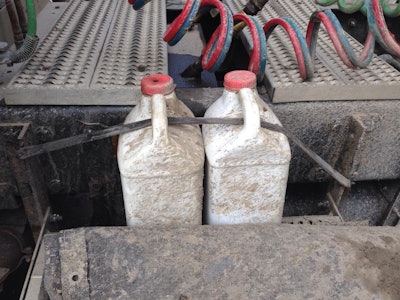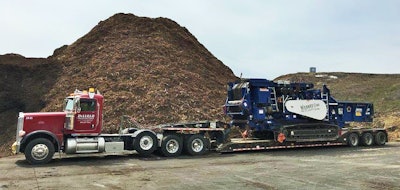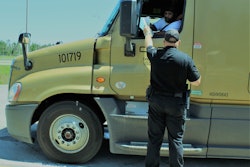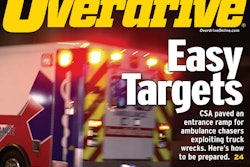Our company’s in great shape, but this system is a broken system. –Bob DeLullo of 16-truck, St. Marys, Pa.-based Dellulo Trucking
What was DeLullo talking about? The bedrock system on which the Federal Motor Carrier Safety Administration’s CSA program, and perhaps more importantly the planned Safety Fitness Determination system, is based. That’d be the one that sends you over the scales on a daily basis or to the roadside for a log check or wider inspection.
DeLullo presents a case in point: His company is a bulk wood-products hauler, mostly hauling its own product with its affiliate Woodbed company. It’s not uncommon for DeLullo drivers to carry two-gallon jugs for situations they might encounter in the course of a workday: One filled with salt, the other with oil.

An inspection in New York resulted in a “hazmat violation,” DeLullo says. The jugs are re-used treatment totes. “So when I buy the jugs, there’s oil in them,” he adds, but once they’re re-used they’re “not an approved container,” the lynchpin of that particular violation.
In a more recent incident, an officer DeLullo describes as a “local city cop” in Warren, Pa., that had been trained to conduct CVSA North American Standard inspections, stopped a DeLullo driver en route to the company’s shop (a few miles away) to repair a tire. “My driver, just the day before, was in a long DOT check, so he wasn’t 100 percent professional with the cop,” DeLullo says. “He was pissed that he had been through it the day before.”
Ultimately, the officer detained the truck for a few hours by issuing two out-of-service violations — one for a flat tire, and another for improper securement. Of what, you ask? Improper securement of the oil jugs bungee’d next to the frame rail behind the cab.
In conversation with DeLullo later, he says, “The cop told, ‘he wasn’t nice,'” referring to the driver. “And I said, ‘Well this is how this works, I guess – this isn’t about safety. This is about just how nice you can be.'”
What it all boils down to, DeLullo says, is as increasing employment of “gotcha-type methods of enforcement,” an attitute of “me against you. I say in any great relationship, it can’t be a ‘me against you’ proposition. As it is, this is the DOT and the federal government against me in this business. I’m 50 years old, and I don’t see why I want to continue to do this.”
The central point of the problem, as DeLullo sees it, is that the increasingly adversarial relationship, the gotcha attitudes and methods he’s seeing, is producing the data that is then being used at the highest levels of the CSA ranking/scoring program to produce the scores that carriers are being judged on. His thoughts on it all are a definite variation on the old “garbage in, garbage out” phrase to describe systems doomed by the component parts on which they are based. (That phrase is one we’ve all heard before when it comes to the CSA program, of course, going back to its early days.)
“Once you get that,” he says, once “you know what that means on the road” during inspections, it’s easy to see it all as a “downward spiral.”
 Bob DeLullo started in trucking as a driver in 1986, he says. Since then, he believes, most aspects of the business of trucking have improved — from equipment to pay and image, however slightly in some cases. “But regulation is going haywire. … The regs side of this business is the single biggest issue we have.”
Bob DeLullo started in trucking as a driver in 1986, he says. Since then, he believes, most aspects of the business of trucking have improved — from equipment to pay and image, however slightly in some cases. “But regulation is going haywire. … The regs side of this business is the single biggest issue we have.”Despite a high percentile in the Crash Indicator BASIC of the CSA Safety Measurement System, “our company’s in great shape, but this system is a broken system,” he adds.
While Congress has taken action on the CSA Safety Measurement System and its categorical percentiles, pulling them from public view pending a review/revamp of the program, FMCSA nonetheless continues to move forward with its long-planned Safety Fitness Determination safety rating system that would lean heavily on roadside inspection/violation data to make the ratings. As reiterated in reporting by James Jaillet just today, there is a push by an ad hoc coalition, including associations representing small carriers around the nation, to halt the SFD rulemaking process by arguing the release of the rulemaking proposal violated Congressional intent in the FAST Act highway bill. As I’ve written before, the coalition argues the proposal should have been held until the CSA SMS was reviewed/revamped, as required by law, given how much the SFD relies on the CSA SMS’ architecture. Read more about it at this link.
If you judge the industry by looking at the CSA SMS, DeLullo says, “the safest carrier on the road is the new carrier, the guy with no history. I’ve been doing this for 30 years and I look worse at a a glance than a brand-new carrier.”
In the final analysis, he says, “In order to conquer things you have to have a two-way working relationship,” he says, one that’s just not there at this point between the industry and law enforcement. “The end result — when you go to the store 10 years down the road, everything’s going to cost more.”










